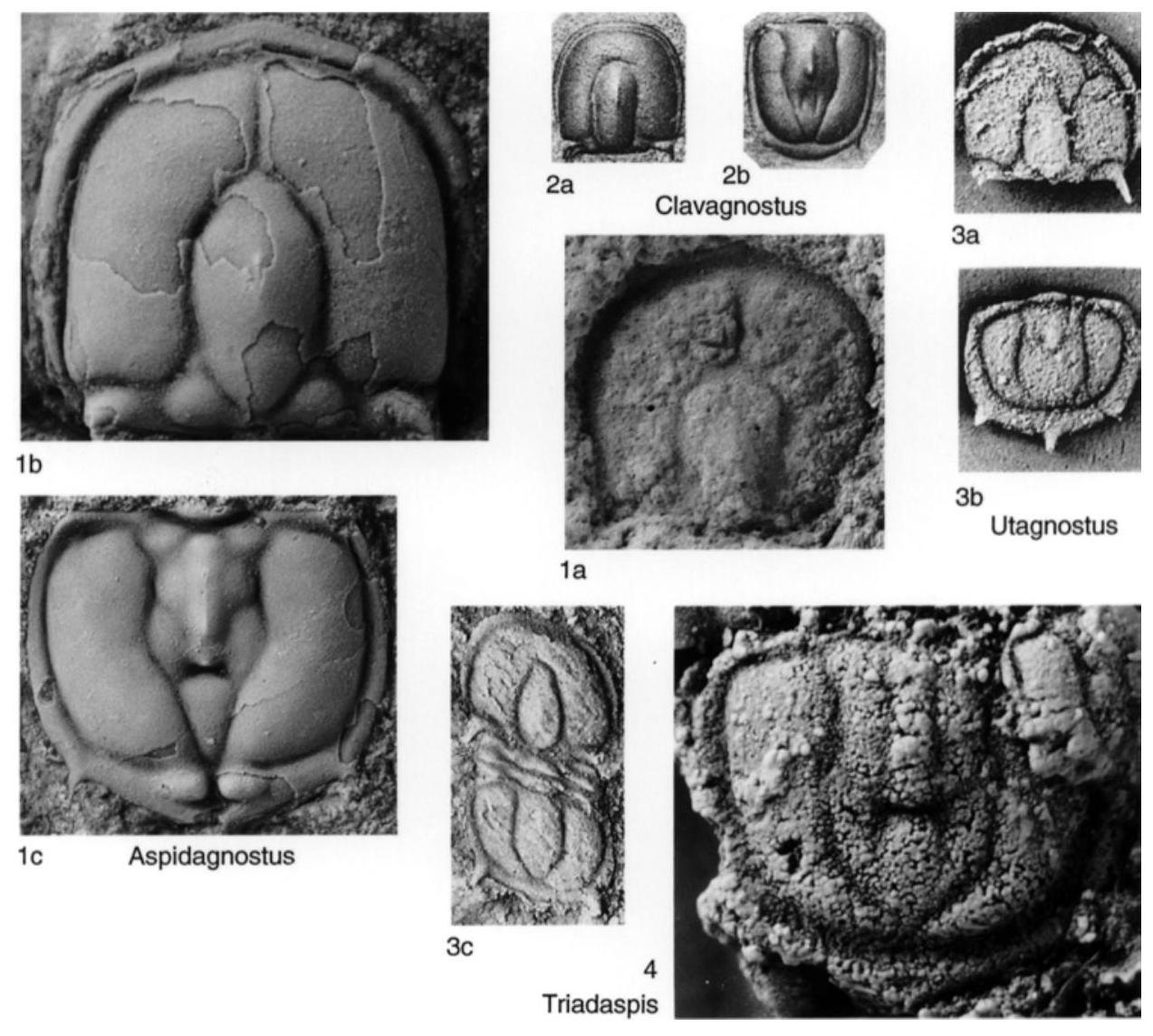Welcome to the Treatise on Invertebrate Paleontology!
Please enter a genera name to retrieve more information.

Aspidagnostus
Classification
Phylum:
Arthropoda
Class:
Trilobita
Order:
Agnostida
Superfamily:
Agnostoidea
Family:
Clavagnostidae
Subfamily:
Aspidagnostinae
Formal Genus Name and Reference:
Aspidagnostus WHITEHOUSE, 1936, p. 104
Type Species:
*A. parmatus; OD; holotype (WHITEHOUSE, 1936, pl. 9, fig. 5), 3213, UQF, Brisbane
Images
(Click to enlarge in a new window)
Fig. 235,1a. *A. parmatus, Upper Cambrian (stage and zone uncertain), Australia (Glenormiston district, western Queensland); holotype, cephalon, UQF 3213, ×12.7 (new).——Fig. 235,1b,c. A. iniquilinus, Upper Cambrian (Mindyallan, Glyptagnostus stolidotus Zone), Australia (Glenormiston district, western Queensland); b, holotype, cephalon, CPC 5828, × 16; c, paratype, pygidium, CPC 5831, ×12 (new).
Synonyms
Biragnostus
Geographic Distribution
Australia (Queensland, Tasmania), G. stolidotus to
G. reticulatus Zones; Kazakhstan, G. stolidotus to G. reticulatus Zones; England, A. pisiformis Zone; Canada (Northwest Territories), Cedaria brevifrons to G. reticulatus Zones; USA (Nevada), upper Crepicephalus Zone, (Alabama, Nevada), G. reticulatus Zone; China (Zhejiang), G. stolidotus to G. reticulatus Zones. Upper Cambrian: Russia (Siberia).
Age Range
Beginning Stage in Treatise Usage:
lower Upper Cambrian
Beginning International Stage:
Guzhangian
Fraction Up In Beginning Stage:
50
Beginning Date:
498.75
Ending Stage in Treatise Usage:
lower Upper Cambrian
Ending International Stage:
Jiangshanian
Fraction Up In Ending Stage:
25
Ending Date:
493.4
Description
Commonly scrobiculate, with nondeliquiate to deliquiate border furrow and anteriorly angulate border in cephalon; median preglabellar furrow well developed. Glabella acuminate or narrowly rounded anteriorly; glabellar culmination narrowly rounded to angular; glabellar
node elongate, located at or in front of glabellar midlength; basal lobes small to moderate-sized, commonly divided. Pygidium with weak to welldeveloped, secondary axial node on posterior lobe; nondeliquiate border furrow and zonate border with collar crossed by deep median gap, commonly flanked by a pair of knobs.
References
Museum or Author Information
Classification
Phylum:
Arthropoda
Class:
Trilobita
Order:
Agnostida
Superfamily:
Agnostoidea
Family:
Clavagnostidae
Subfamily:
Aspidagnostinae
Formal Genus Name and Reference:
Aspidagnostus WHITEHOUSE, 1936, p. 104
Type Species:
*A. parmatus; OD; holotype (WHITEHOUSE, 1936, pl. 9, fig. 5), 3213, UQF, Brisbane
Images
(Click to enlarge in a new window)
Fig. 235,1a. *A. parmatus, Upper Cambrian (stage and zone uncertain), Australia (Glenormiston district, western Queensland); holotype, cephalon, UQF 3213, ×12.7 (new).——Fig. 235,1b,c. A. iniquilinus, Upper Cambrian (Mindyallan, Glyptagnostus stolidotus Zone), Australia (Glenormiston district, western Queensland); b, holotype, cephalon, CPC 5828, × 16; c, paratype, pygidium, CPC 5831, ×12 (new).
Synonyms
Biragnostus
Geographic Distribution
Australia (Queensland, Tasmania), G. stolidotus to
G. reticulatus Zones; Kazakhstan, G. stolidotus to G. reticulatus Zones; England, A. pisiformis Zone; Canada (Northwest Territories), Cedaria brevifrons to G. reticulatus Zones; USA (Nevada), upper Crepicephalus Zone, (Alabama, Nevada), G. reticulatus Zone; China (Zhejiang), G. stolidotus to G. reticulatus Zones. Upper Cambrian: Russia (Siberia).
Age Range
Beginning Stage in Treatise Usage:
lower Upper Cambrian
Beginning International Stage:
Guzhangian
Fraction Up In Beginning Stage:
50
Beginning Date:
498.75
Ending Stage in Treatise Usage:
lower Upper Cambrian
Ending International Stage:
Jiangshanian
Fraction Up In Ending Stage:
25
Ending Date:
493.4
Description
Commonly scrobiculate, with nondeliquiate to deliquiate border furrow and anteriorly angulate border in cephalon; median preglabellar furrow well developed. Glabella acuminate or narrowly rounded anteriorly; glabellar culmination narrowly rounded to angular; glabellar
node elongate, located at or in front of glabellar midlength; basal lobes small to moderate-sized, commonly divided. Pygidium with weak to welldeveloped, secondary axial node on posterior lobe; nondeliquiate border furrow and zonate border with collar crossed by deep median gap, commonly flanked by a pair of knobs.
